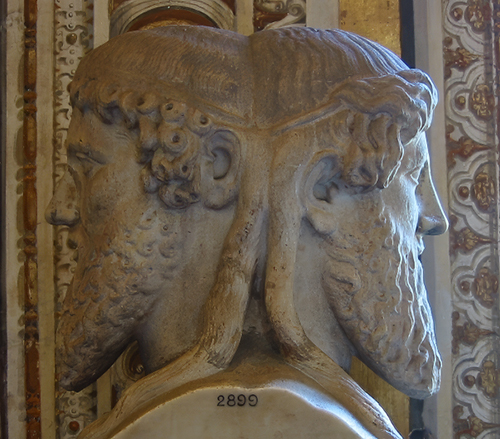The Vatican Museums in Rome feature extraordinary art and historical treasures.
Visitors can explore a vast collection amassed by the Catholic Church and the papacy over centuries. Highlights include iconic Roman sculptures and some of the world’s most significant Renaissance masterpieces.
The museums contain roughly 70,000 works, of which 20,000 are on display, including the Sistine Chapel with its ceiling decorated by Michelangelo.
They rank second in the list of most-visited art museums in the world after the Louvre.

One of the items on display is a bust of the Roman god, Janus.
This bust is of two heads looking in opposite directions.
I am reminded immediately of this statue as I read today’s Gospel (Jn 6:60 -69).
“So Jesus asked the twelve, “Do you also wish to go away?” Simon Peter answered him, “Lord, to whom can we go? You have the words of eternal life. We have come to believe and know that you are the Holy One of God.” (vv. 67ff)
“Lord to whom can we go?” – such a declaration of faith.
However, from the mouth of this same man we hear, “Now Simon Peter was standing and warming himself. They asked him, “You are not also one of his disciples, are you?” He denied it and said, “I am not.” One of the slaves of the high priest, a relative of the man whose ear Peter had cut off, asked, “Did I not see you in the garden with him?” Again, Peter denied it, and at that moment the cock crowed.” (Jn. 18:25 – 27)
Can it possibly be the same man?
“Who can we go to?”
“I am not!”
Nicholas of Cusa [1401–1464]) was a German Catholic theologian who coined the phrase the coincidentia oppositorum – or “coincidence of opposites” .
Such a phrase sums up the life of St. Peter.
And mine/ours!
The “coincidence of opposites.” – This is what we all resist and oppose much of our life.
How do you live with your own contradictions and inconsistencies?
There has been a theology which maintains we “eliminate” one of the opposites.
Maybe it is not about ‘eliminating’ rather, holding the opposites, as Jesus did on the cross. To live inside this space of creative tension is the very character of faith, hope, and love.
An example from my own life.
I am an ordained priest in the Roman Catholic Church. As such I am called to live a life of celibacy (that is to remain single)
I am also a professed member of a religious congregation, (The Society of Mary). Part of that profession is a vow of chastity.
I am also a male, with all the sexual energy and potential that is inherent in being male.
There is the possibility for conflict between the ordained, professed state and the primary energy inherent in being male.
In my early years I presumed fidelity meant eliminating. However, eliminating meant denial of an essential part of my constituent being.
I now believe, and I need acknowledge the belief is mine, that I am now invited to live within the “tension of opposites!”
And, don’t we all? Frequently, as an ordained priest I sit in the confessional and hear the same penitent week in and week out confessing the same fault. It says little for the efficacy of the Sacrament. Or does it?
Might it be that living within the “tension of opposites” is where we are called to live and the Sacrament of Reconciliation ceases to be an exercise of expulsion and elimination but rather an expression of the “coincidence of opposites.”
Remember, Jesus was crucified between two thieves, a Good Thief and a Bad Thief, and he spoke with both! “There they crucified him, and with him two others, one on either side, with Jesus between them.” (Jn 19: 18)
